#kimiidera
Explore tagged Tumblr posts
Text

A full view of Kimiidera Temple (紀三井寺) in Wakayama City, Wakayama Prefecture, as it appeared in the early twentieth century (1918-1933)
Una vista completa del Templo Kimiidera (紀三井寺) en la ciudad de Wakayama, prefectura de Wakayama, tal como era a principios del siglo XX (1918-1933)
Postcard from the photography collection of the Nara Prefectural Library
#buddhist temple#紀三井寺#kimiidera#和歌山県#wakayama prefecture#和歌山市#wakayama#西国三十三所#postcard#絵はがき#ephemera#printed ephemera#paper ephemera#historic photo#foto historica#templo budista#tarjeta postal
19 notes
·
View notes
Text
August 14-15, 1979: Kimiidera Temple & Mount Koya, Wakayama


0 notes
Text
西国三十三観音1番ー5番;和歌山と南大阪
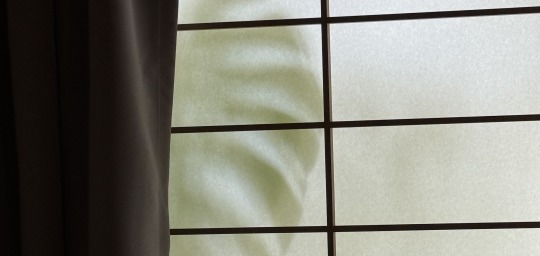
1. Seiganto-ji, Wakayama (February 11, 2025)
I take the day off work, and M and I head down the coast in a rented Yaris. I’ve been dying to do this trip for more than a year now, and I finally have a willing driver. We’ll stop first at an onsen hotel in Katsuura before using the entire second day of our trip to hit the Kumano Sanzan and fully explore the area. There’s quite a bit of driving involved. To fill the silence, M and I learn facts about the area and find creative ways to parrot them back at each other in the car. Did you know that Nachi Falls is the tallest single drop waterfall in Japan? Did you know that the natural hot water in what would become Yunomine Onsen was first recorded 1500 years ago? Did you know that you’re my best friend, and I think I’m yours, too?
Kumano Nachi Taisha is quiet but alluring. It stands imposingly on the side of a mountain, and the top of the waterfall that backgrounds the entire site comes closer and closer to eye level at every landing on the stone steps. Seiganto-ji itself is built of heavy, dark wood that seems to radiate a sort of silent reverence from the sheer width of the planks alone; it stands in stark contrast to the newly renewed bright orange five-story pagoda that makes up the iconic facade of Nachikatsuura. We climb into a tree, and then out of it. I receive the temple’s goshuin, and marvel at the time and effort it’s taken to get here: it’s the first step of the route around all thirty-three.
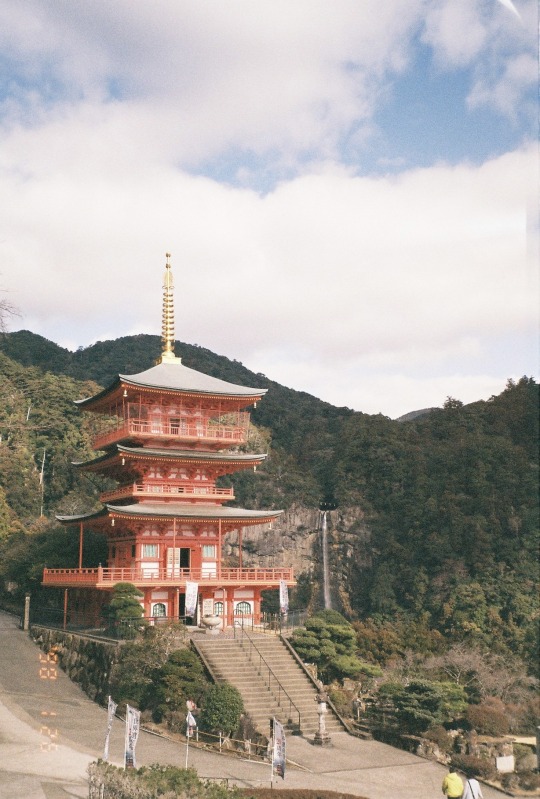
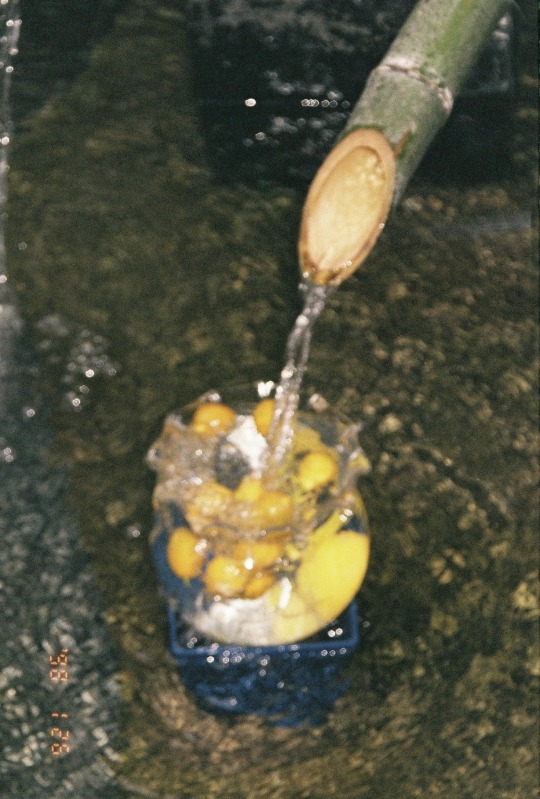
We stop in Shingu for enormous bowls of Wakayama ramen for lunch, and pair hot conbini coffee with sweet, thick-skinned oranges to combat the three o’clock slump. Kumano Hatayama Taisha is the second of the three shrines, and sits at the mouth of the Kumano River. I can’t believe how culturally dense the area is. Around every bend in the road is another stunning vista – only they’re not just vistas, they’re also sites that have commanded divine energy for years, and are enshrined in the native syncretic religion. The Kumano River widens and narrows as we drive alongside it, keeping its own time. The details of the day escape me, but for as much as every moment in between stops slips away, the rooted ancient structures are solid and immovable.
Our last stop among the Kumano Sanzan is Kumano Hongu Taisha, which is home to a tourism center that is so good it reminds me that I need to go back to school. By far the most interesting thing I learn all day is that the Kumano Kodo and El Camino in Spain are sister pilgrimages, and a handful of people have been rewarded with the status of Dual Pilgrim for completing both. A video in the tourism center shows rows and rows of shugenja in Santiago de Compostela, and a Shinto cleansing ritual on the main altar of the cathedral. I’m blown away not only at this tie across cultures and countries, but the emphasis on the connection to land: foot to ground, emphasis on Place over place.
In the tourism center I see a picture of Yunomine Onsen and insist we do a drive by. I’m sad that we don’t have time to bathe for about twenty minutes, which is how long it takes for the migraine from the absolutely inescapable reek of the sulfur starts to set in. We head back up the coast, return the car to Yokkaichi just in time, and eat tonteki for dinner before crashing back at my house.
2. Kimiidera, Wakayama (April 16th, 2025)
While increasingly aware of my tenuous legal status in Japan before I receive my Expo visa, I decide to make the most of it by using my Japanese driver's license that is only valid with my accompanying residence card. On a sunny Wednesday morning, I take off for Kimiidera in (another) rented Yaris.
The temple creeps up out of nowhere, tucked in the mountains between residences and apartment buildings, but similarly to many of the more suburban temples out of the 33, the complex is large and welcoming. The new greenery on the trees is particularly bright on this day, and I’m greeted by a lovely ocean view over southern Wakayama City. I think of A, who once told me that Japanese maple leaves casting shadows in spring is like stargazing all day long. A handful of tourists chat in Cantonese, but for the most part, the temple grounds are quiet. Wisteria are starting to bloom near the temple office, and the familiar ping-ping-ping of a railroad crossing sounds.
While the enshrined Kannon that I am here to pay respects to is difficult to see through the glass in the main hall, another tall building in the complex houses a large golden thousand hands Kannon that stretches from the ground up to the third floor of the pagoda. It’s hard to make eye contact with her from that height, but I stand at her feet and wish for safe passage over the rest of my trip.
As I walk down the stairs to leave, I hear a nearby school’s bell ring and check the time out of instinct; third period is over. It’s been a month since I left my job in a high school on the opposite coast of this penninsula. Perhaps the sound carries farther in the ocean breeze.

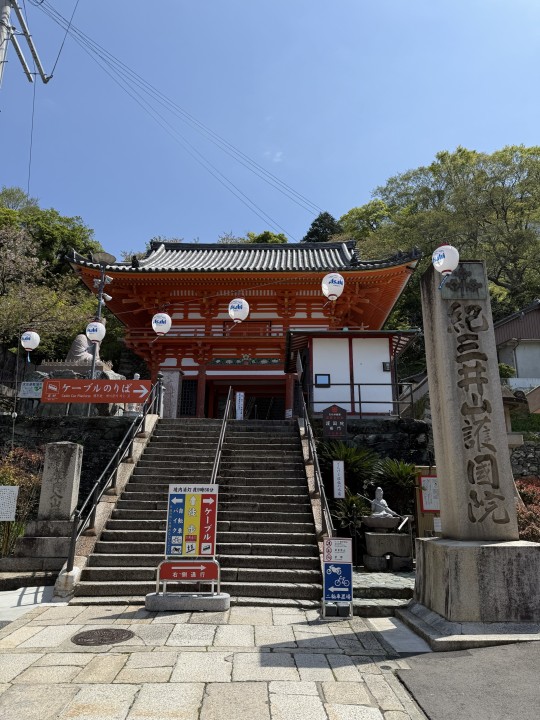
3. Kokawadera, Wakayama (April 16th, 2025)
I meet several characters at Kokawadera. The moment I park my car, a woman calls out to me to sell me oranges; it has to be her easiest sale of the day. Kokawadera is another large complex, which similarly to Kimiidera, is in the last legs of its cherry blossom bloom. The main temple stands regally, framed by a rock garden and several imposing buildings, but just slightly off the main temple is a walled garden in a state of disrepair. Tarps and foam board cover broken doors and entryways, weeds encroach on the walkway. I spend too long looking at a pond filled with red lilypads looking for the source of a strange noise before finally spotting a fat frog. A notice on the main building in the garden says that it’s closed until further notice, but does provide a mosaic of pictures of what the garden used to look like. It’s strange to see the once-beautifully manicured place in pictures only. Stacks of new shingles are piled under the stairs; a hydrangea starts to bloom in an unripe green.
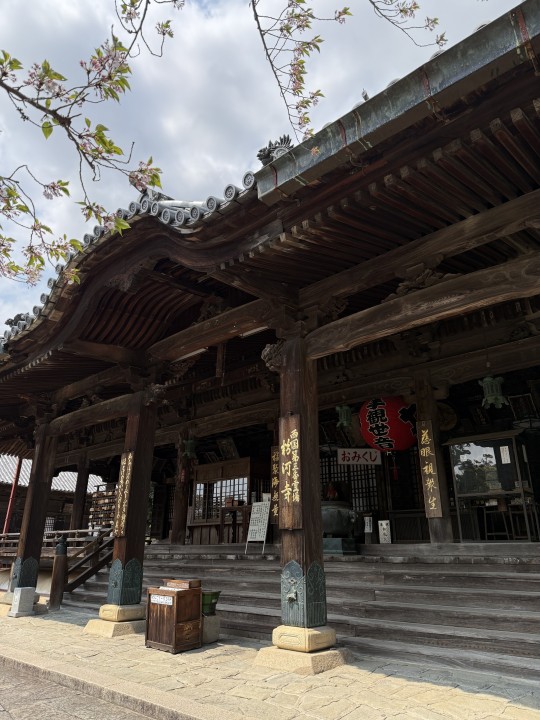
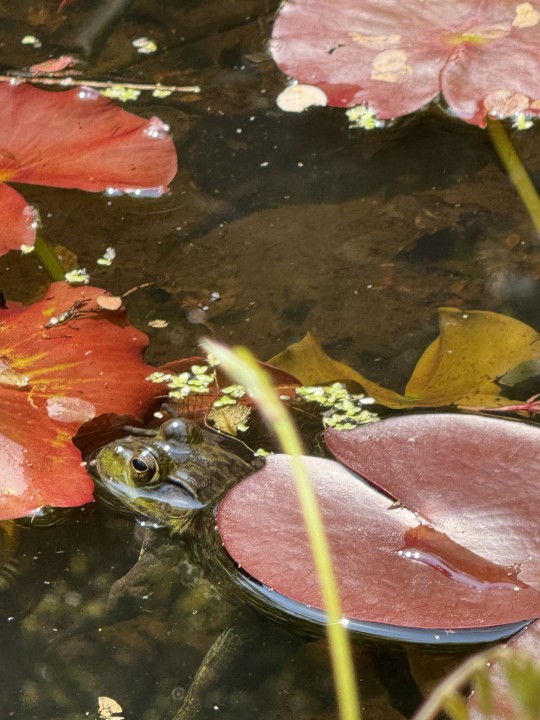
The next people I meet are two old men sitting on the curbside drinking Strong Zero and smoking cigarettes. It’s around 1PM. They say hello, ask where I’m from, invite me into their supermarket to drink some tea, which I decline. I’ve decided to walk from the temple to the train station and back just to stretch my legs before my long drive, and am now nervous to walk past them on the way back to the car, but they’re gone when I return. Maybe back to work.
By the station, I stop at a quiet, dusty camera store. I do my best to small talk with the owner, but he inevitably asks where I’m from. I tell him I’m an American living in Mie. He doesn't have any more questions, but I fire back with one of my own and learn that he’s Kokawa born-and-raised. I ask to take a closer look at a camera on a shelf, but he tells me they’re all display only and not for sale.
Here, I perhaps most strongly feel what I know to be a truth of this area: this part of the Kii Peninsula is particularly economically depressed and suffers greatly from population decline. Most of the shops are boarded up and look like they haven’t been open for years, although some unmanned second hand stores and community centers indicate a beating heart in this small town. In one of the stores, two notebooks left on a table invite visitors to write whatever they want in them – hopes, dreams, complaints. I flip through both and they’re empty. I leave Kokawa with a strange feeling – thankful, again, for the conversations and the safe passage, but certain that this town may be asking me for something that I am not able to give it.
4. Sefukuji, Osaka (April 17th, 2025)
I make some impatient decisions before heading to Sefukuji; namely, I decide that I will make the most of the money I’ve paid for this rental car and will sprint up the mountain if it means making in in time to see the main hall of the temple and receive my goshuin. Despite the Google reviews, the hike is really closer to twenty minutes than forty, and I make it up to the top of the mountain with plenty of time to spare, only to find no one sitting at the reception. I knock on the window and call out, but no one comes. I wonder if this is finally the level of inaka where even sheer force of will can’t save me, and wring my hands at the window fretting over the prospect of having driven all this way and busted ass up the mountain for nothing. Five minutes before close, a man appears out of thin air and makes a scribbling motion at me, to which I must look particularly desperate, because he hurries me over and accepts my book without a single word. I get my goshuin and enter the main hall to pay respects to the Kannon-sama I’ve come to visit, and am happily marching down the mountain by a respectable 5:30. It is literally the perfect spring day: the air is still and fragrant with petrichor, the sun is low and gentle in the sky. The temple is gorgeous and well maintained. I’ve just come from a day in Koyasan, and am able to recognize the imagery and influence of Kūkai stretching into southern Osaka. I feel nourished in a way that lies somewhere off the way I am used to.
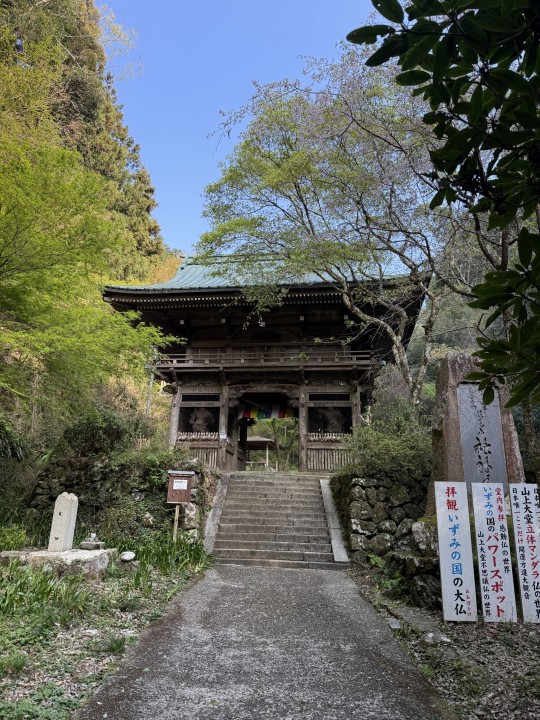
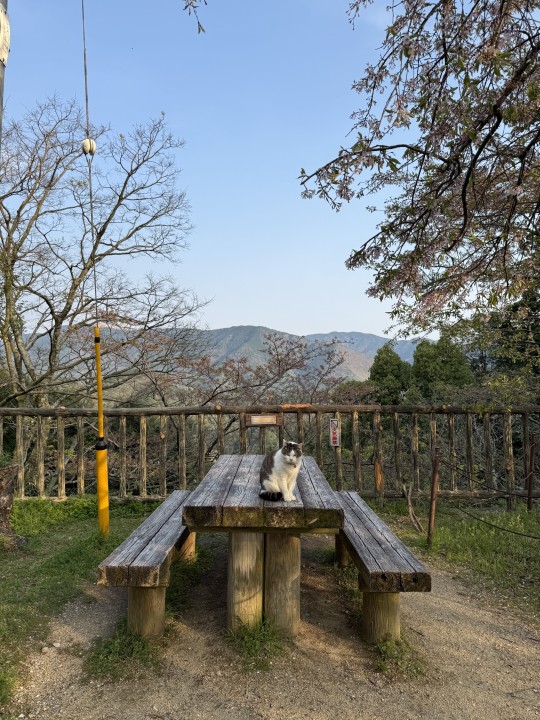
It’s a helpful reminder: if I forget to be patient, I will be reminded. I spend most of the rest of my visit petting Fukuchan, the fat temple cat who knocks her head against my hand if I stop scratching her for too long – concentrated action, direct outcome.
5. Fujiidera, Osaka (April 25th, 2025)
I visit Fujiidera in salaryman cosplay, because I’m working an afternoon shift at the Expo later that day. Clad in sensible work pants and polo, I ride three trains to arrive in Fujiidera, a lively neighborhood in Minamiosaka. The wisteria blossoms — the temple’s namesake — are in peak bloom, and hang heavily with purple and white flowers on trellises that guide me from the station straight to the gate of the temple. On the grounds, a few older gentlemen sell handmade Kannon-sama and wisteria goods.
Fujiidera feels lived-in, appearing out of nowhere along the covered shopping street. It doesn’t have a particularly grand main gate, like Kokawadera, or a iconic image, like Seiganto-ji. Just as the vegetable seller and the bookstore, it’s a community staple. Here is where you might buy your fruits for the week, here is where you can get your shoes repaired, here is where you might find something greater than yourself in the mercy of the Kannon-sama’s gaze. I feel like I’ve made a move towards that quotidian too, in which Buddhist practice isn’t so much as an outing or a mission but a base to return to, over and over, present in the moments of pause and beats between breaths. A walk in the park takes on the rhythm of meditation, dinner with friends is shaped like a sangha, and the commute to work takes a detour to here.
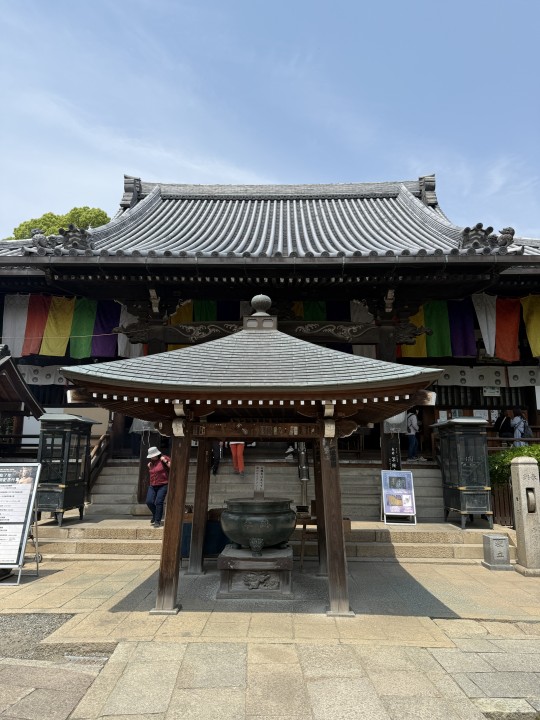

In the station, a watercolor mural tells the story of Fujiidera station. A small town grows up around the temple, developing from a one-track railhouse next to a rice field to a bustling station and shopping street. J once told me that the reason that language acquisition is so difficult and yet so satisfying is because learning a second language isn’t being able to say the same thing two different ways, but instead growing an entire second being from scratch, one who must learn the unfamiliar, enculturated way of being human. As I learn the lexicon of a Buddhist life, I feel myself tottering and frustrated in the same way that children who can’t quite articulate themselves yet are. Things challenge me in ways that I can’t explain, I’m drawn to others unexpectedly, I spend entire days confused and angry and outside myself. I’m learning a practice that I can tell will nourish me in years to come, but don’t quite yet have the words to say how or why. I must build the temple first, the adolescent town second. I have much to learn.
Dear reader,
The Saikoku Kannon Pilgrimage is the oldest pilgrimage in Japan and has been practiced for over 1300 years. It consists of thirty three sacred sites associated with the Bodhisattva of Mercy, spread across five areas in Western Japan. I hope to complete this route before October of this year, when I will likely conclude my time living here. Thank you for reading. To be continued...
1 note
·
View note
Text
ENC STUDY SESSION SUNDAYS.
Wakayama Prefectural Medical University Library Kimiidera Main Buiding
Library, 811-1 Kimiidera, Wakayama, 641-0012, Japan
0 notes
Text
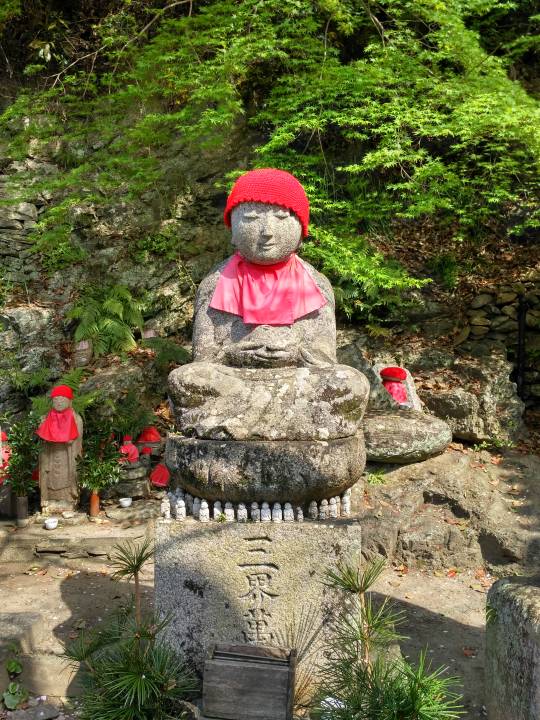
kimiidera, wakayama
do all gizos get new hats in spring?
est-ce que tous les gizos recoivent un nouveau bonnet au printemps?
1 note
·
View note
Photo
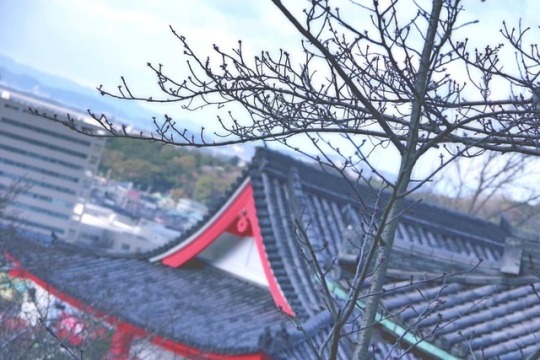
和歌山ものんびり過ごせて楽しかった〜! 今から福岡行ってケバブ食べて 沖縄に向かいます✈️💫 #photography #photogenic #photo #photographer #kimiidera #wakayama #japan #japanese #写真撮ってる人と繋がりたい #写真を撮るのが好きな人と繋がりたい #写真 #ファインダー越しの私の世界 #temple (Kimiidera Temple)
#photographer#ファインダー越しの私の世界#写真#photography#photogenic#wakayama#japan#写真を撮るのが好きな人と繋がりたい#photo#temple#japanese#kimiidera#写真撮ってる人と繋がりたい
0 notes
Photo
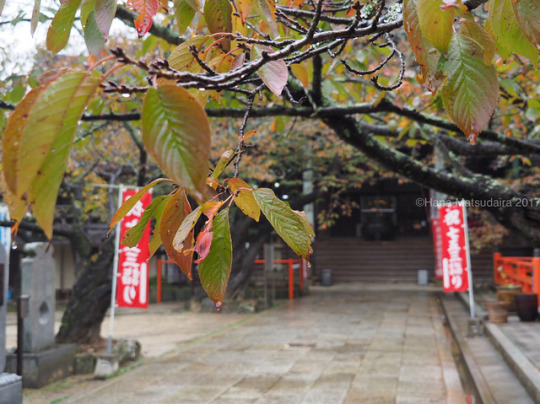
#travel #japan #photography #wakayama #temple #kimiidera #rainnyday #和歌山 #日本 #写真 #旅行 #紀三井寺
0 notes
Photo

English: Kimiidera in Wakayama, Wakayama prefecture, Japan
日本語: 紀三井寺, 和歌山県和歌山市
1 note
·
View note
Text
4 nơi ngắm hoa anh đào nở ở Wakayama
New Post has been published on https://khachsanthanhdong.com/4-noi-ngam-hoa-anh-dao-no-o-wakayama.html
4 nơi ngắm hoa anh đào nở ở Wakayama
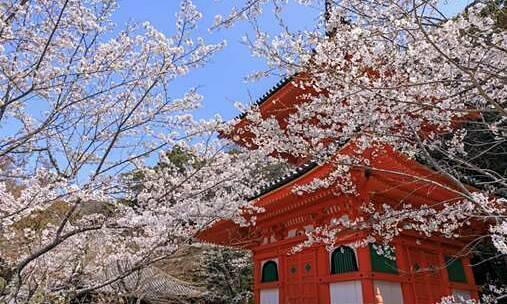
Tại tỉnh Wakayama, Nhật quý khách dạng, từ cuối tháng 3 – giữa tháng 4 có hoa anh đào nở rực khắp phố phường, báo mùa xuân về. Với người dân Wakayama, hoa anh đào là món vàng ý thức, mang tới thú vui và may mắn dịp đầu năm. Để ngắm hoa anh đào, người dân thường tới 4 nơi sau:
Thành Wakayama
Thành Wakayama được xây dựng trên núi Torafusuyama, trung tâm TP Wakayama. Tòa thành xây dựng lần trước tiên theo lệnh của lãnh chúa Toyotomi Hideyoshi vào năm 1585. tới thời đại Meiji, thành bị phá hủy một phần. Sau đó, trải qua chiến tranh toàn cầu lần 2, thành Wakayama đãbị thiêu cháy. Sau chiến tranh, thành được tái khôi phục và được giữ gìn tới ngày nay và trở thành nơi người dân Wakayama tới vui chơi và dạo bộ.
Thành Wakayama còn có tên gọi khác là Torafusu-jo nếu lấy theo tên của ngọn núi. Đứng trên tháp canh trong tòa thành sẽ nhìn được toàn cảnh TP cùng con sông Kinokawa xung quanh thành. Vào mùa xuân, thành Wakayama được 600 cây hoa anh đào bao bọc. Hoa nở rực rỡ từ cuối tháng 3 tới giữa tháng 4.

Hoa anh đào nở trong Thành Wakayama.
Chùa Kimiidera
Chùa Kimii-dera còn được gọi là Kimiisangohoji Gokokuin, xây dựng vào năm 770. Trải qua những thăng trầm của nhiều triều đại khác nhau, tới nay ngôi chùa còn lưu giữ rất nhiều cổ vật. Trong sân chùa có 3 giếng nước với mạch nước ngầm tinh khiết: Shojosui, Kisshosui, Yoryusui. Ngôi chùa này được tiến công giá là 1 trong 100 nơi có nguồn nước sạch sẽ nổi tiếng Nhật quý khách dạng.
Trong khuôn viên chùa trồng khoảng 500 cây hoa anh đào. Kimii-dera nổi tiếng là nơi có hoa anh đào nở sớm ở vùngKansai.
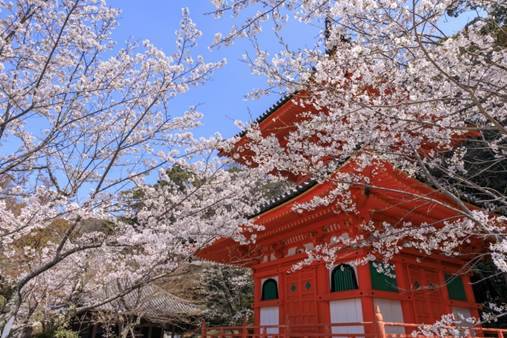
Chùa Kimii-dera có hoa anh đào nở sớm.
Công viên Heisogen
Nằm tại thị trấn Shirahama, công viên Heisogen trồng khoảng 2.000 cây hoa anh đào Yoshino. Mỗi mùa hoa anh đào, công viên rợp sắc hồng của cánh hoa. Giống anh đào Yoshino có mùi thơm, từ công viên mùi hoa bay lan sang thị trấn.
Bên trong công viên có sân thể thao rộng để tổ chức lễ hội hoa anh đào vào hàng năm. Lễ hội thường có các gian hàng thực phẩm cùng những đèn chiếu sáng để du khách ngắm hoa anh đào vào đêm tối.
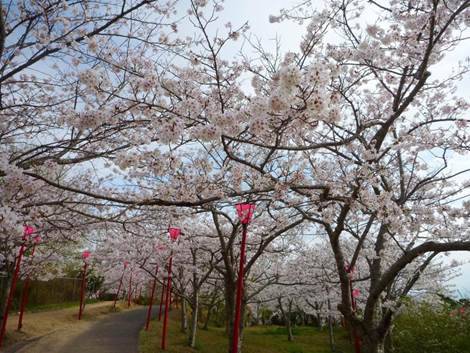
tới công viên Heisogen, du khách có thể ngắm hoa anh đào vào đêm tối.
Đền Kongobuji
Toyotomi Hideyoshi xây dựng vào năm 1593, sau đó được sát nhập với đền phụ cận trở thành ngôi đền trước tiên của Phật giáo Shingon. Bên trong ngôi đền có các tòa nhà với các lớp cửa được trang trí sống động. Tòa nhà chính bên trong ngôi đền Kongobuji được sử dụng để tiếp các vị khách quý, trên tường và cửa trượt được mạ vàng và trần nhà có hoa chạm khắc.
Đằng sau tòa nhà có vườn đá Banryutei, xây dựng vào năm 1984. Những tảng đá lớn trong vườn được lấy từ Shikoku, nơi sinh của Kobo Daishi biểu tượng cho một cặp rồng nổi lên từ một đại dương mây. Trong khuôn viên đền trồng rất nhiều cây hoa anh đào rủ màu hồng đậm tỏa sắc cho ngôi đền.
(Nguồn: Trung tâm giao lưu thông tin Du lịch Nhật quý khách dạng JTICC)
Info: https://khachsanthanhdong.com/
0 notes
Photo
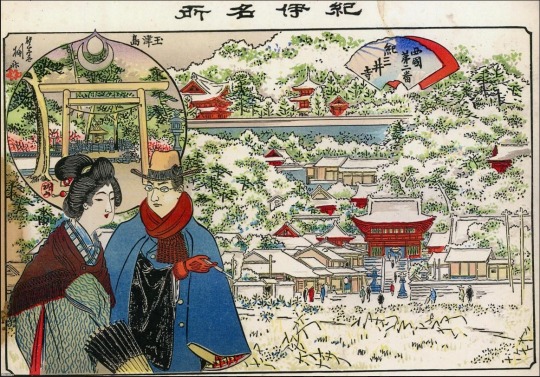
An 1897 postcard featuring the famous sites of Kii Province (in Wakayama City): Kimiidera Temple (紀三井寺) and Tamatsushima Jinja Shrine (玉津島神社)
#japanese art#紀伊国#紀州#kii province#和歌山県#wakayama prefecture#和歌山市#wakayama#紀三井寺#kimiidera#西国三十三所#玉津島神社#tamatsushima jinja#postcard#ephemera#printed ephemera#paper ephemera
16 notes
·
View notes
Note
Woooowwww, hbs liat post-post, jd mau nabung dari sekarang nihh. Itu yg marine park Kushimioto sama Taiji (cmiiw) lengkap banget ya satwa laut nya? Maklum, saya pecinta satwa dr kecil (dulu kecil saya msh ada VCD2 dokumenter semua hehe). Mikirnya sih ntar kalo jalan-jalan ke sana, seputar Kansai dulua aja kalo saya. Penasaran jg sama otera di sana
Hmm, Marine Park Kushimoto lebih lengkap koleksi satwa lautnya sih daripada Museum Paus Taiji
Kalau mau yang hewan-hewan darat, bisa ke Adventure Land yang ada di Shirahama. Bisa lihat panda di situ!
Tera atau kuilnya juga bagusss, di Kota Wakayama ada kuil Kimiidera!
Bisa lah ya coba-coba mampir ehehehe~
5 notes
·
View notes
Photo

Kimiidera, Wakayama-shi, WAKAYAMA JAPAN
0 notes
Photo
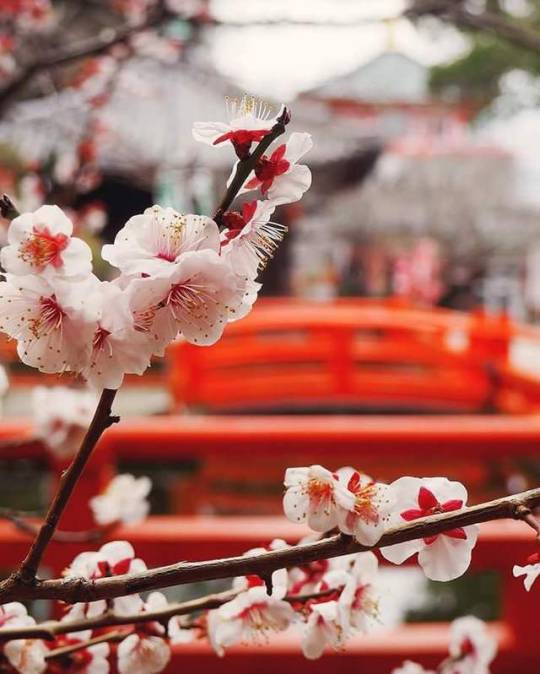
"Beautiful blossoms captured by JapanLover Jayne (www.instagram.com/jayneytravels) at Kimiidera Temple. Also, who's going to Japan for the sakura? 🌸 🌸 🌸 🙋" Via JapanLover Me on Facebook su We Heart It - http://weheartit.com/entry/281487702
4 notes
·
View notes
Photo
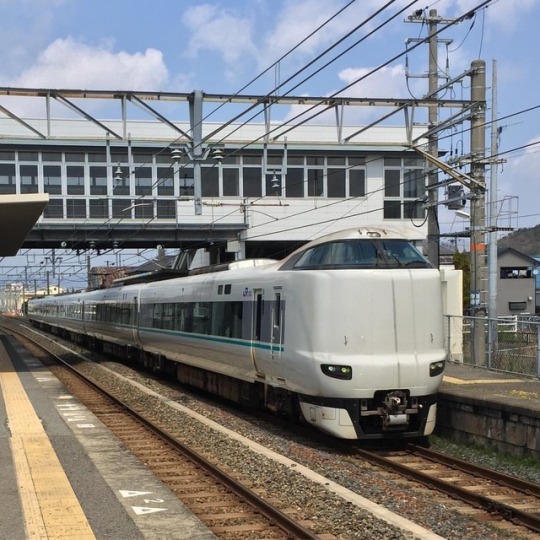
くろしお通過 #jr西日本 #くろしお #通過列車 #紀三井寺駅 (Kimiidera Station)
1 note
·
View note
Photo
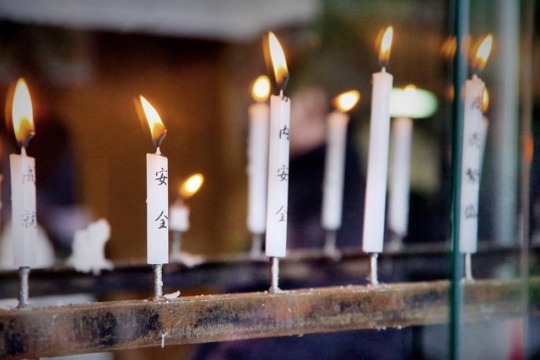
「 文化 」 和歌山の紀三井寺はロウソクに祈願内容が書かれており、参拝者はそこから選んで火をつけ真ん中にある棚にロウソクを置き本殿で参拝すると言う参拝の仕方! 初めてこう言うの見たからなんか新鮮だった、 #wakayama #kimiidera #temple #japan #japanese #pentax #pentaxk70 #アサヒカメラ #tokyocameraclub #photography #photo #photogenic #photographer #写真撮ってる人と繋がりたい #写真を撮るのが好きな人と繋がりたい #写真 #写真好きな人と繋がりたい #寺院 #ファインダー越しの私の世界 (Kimiidera Park)
#寺院#ファインダー越しの私の世界#japanese#写真#tokyocameraclub#pentax#アサヒカメラ#photography#写真撮ってる人と繋がりたい#photo#photogenic#photographer#kimiidera#写真好きな人と繋がりたい#japan#pentaxk70#wakayama#temple#写真を撮るのが好きな人と繋がりたい
0 notes